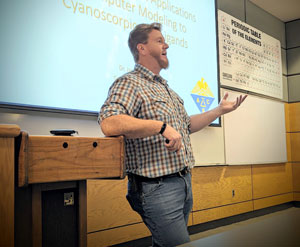

 Dr. Jason Martin presented “Chemistry in Silico: Applications of Computer Modeling
to Cyanoscorpionate Ligands,” as part of the guest speaker series for the American
Chemical Society at NPC. Dr. Martin holds a Bachelor of Science in Chemistry with
a double minor in Math and Physics, as well as a Ph.D. in Physical Chemistry.
Dr. Jason Martin presented “Chemistry in Silico: Applications of Computer Modeling
to Cyanoscorpionate Ligands,” as part of the guest speaker series for the American
Chemical Society at NPC. Dr. Martin holds a Bachelor of Science in Chemistry with
a double minor in Math and Physics, as well as a Ph.D. in Physical Chemistry.
Students, faculty, and staff attended the lecture Friday, September 15. Martin’s presentation
explained how computers were being used to do computations in chemistry, particularly
how he used his Linux workstation to study four compounds his colleague, Dr. Lava
Kadel, asked him to study.
When Martin was asked why chemists do this kind of study he stated, “Whenever you
are doing a computational study, you are usually trying to give additional evidence
to say yes, their geometry or their structure is correct. We verify experimentally
and also theoretically, so that's primarily what you're doing when you're doing a
computational study.”
Martin shared with the audience the specifications of his workstation, which included
128 gigabytes of random-access memory (RAM). Afterward, he was asked if that size
of memory was normal for this type of computer. Martin replied, “For workstations
like this, that’s pretty normal because you typically don't store a whole lot of big
data on the hard drive, but it does need a lot of random-access memory as it's doing
the computation.”
Martin said this topic was challenging to present due to the diverse levels of understanding
in the audience, but he also said it was satisfying because he wants NPC students
to know that the faculty here are actively engaged in research projects and like to
get students involved whenever and wherever they can.
Martin explained how students tend to develop understanding when they get involved
in real-life projects. He hopes to publish a paper on this study in the future.